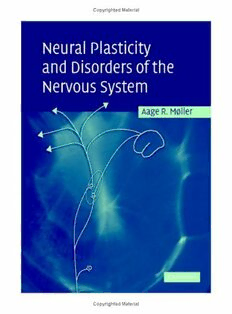Table Of ContentNeural Plasticity and Disorders of
the Nervous System
Neural Plasticity and Disorders of the Nervous System provides comprehensive
coverage of the pathophysiology of neurological disorders emphasizing those
disorders where expression of plasticity is evident. Including the basis for the
expression of neural plasticity; how reorganization of the nervous system can
cause hyperactivity in sensory systems producing central neuropathic pain,
tinnitus and paresthesia; the role of little-known non-classical pathways in
pain and sensory disorders and their subcortical connections; hyper- and
hypoactivity of motor systems after injury, and the role of spinal reflexes and
internal processing in the spinal cord. Phantom symptoms and disorders of
nerves and associated disorders are discussed, along with disorders that can be
cured by microvascular decompression operations. A detailed and
comprehensivedescriptionoftheorganizationofpaincircuitsandsensoryand
motor nervous systems is also included. Neural Plasticity and Disorders of the
Nervous System is aimed at students and graduates of neuroscience and
medicine.
DR. AAGE R. MØLLER is Professor and holder of the M. F. Jonsson Chair at the
University of Texas at Dallas, School of Behavioral and Brain Sciences and
Callier Center for Communication Disorders. He teaches neuroscience,
disorders of neurological disorders and the physiological and anatomical basis
for intraoperative neurophysiologic monitoring.
Neural Plasticity
and Disorders
of the Nervous
System
Aage R. Møller
cambridge university press
Cambridge, New York, Melbourne, Madrid, Cape Town, Singapore, São Paulo
Cambridge University Press
TheEdinburghBuilding,Cambridgecb22ru,UK
Published in the United States of America by Cambridge University Press, New York
www.cambridge.org
Informationonthistitle:www.cambrid ge.org/9780521846677
© A. Møller 2006
Thispublicationisincopyright.Subjecttostatutoryexceptionandtotheprovisionof
relevant collective licensing agreements, no reproduction of any part may take place
without the written permission of Cambridge University Press.
Firstpublishedinprintformat 2006
isbn-13 978-0-511-13986-4 eBook(EBL)
isbn-10 0-511-13986-1
eBook(EBL)
isbn-13 978-0-521-84667-7 hardback
isbn-10 0-521-84667-6 hardback
Cambridge University Press has no responsibility for the persistence or accuracy of urls
forexternalorthird-partyinternetwebsitesreferredtointhispublication,anddoesnot
guaranteethatanycontentonsuchwebsitesis,orwillremain,accurateorappropriate.
Contents
Acknowledgementspage vii
List of abbreviations viii
Introduction 1
1 Anatomical and physiological basis for neural plasticity 7
Introduction 7
1.1Advantagestotheorganismfromneuralplasticity 7
1.2Disadvantagestotheorganismfromneuralplasticity 13
1.3 Promotersofneuralplasticity 15
1.4 Basisforneuralplasticity 17
1.5 Diagnosisandtreatmentofdisorderscausedbyexpressionofneural
plasticity 32
2 Nerves 42
Introduction 42
2.1 Symptomsandsignsofdisordersofnerves 43
2.2 Anatomyandphysiologyofnerves 47
2.3 Pathologiesofnerves 51
2.4 Pathophysiologyofdisordersofnerves 57
3 Sensory systems 68
Introduction 68
3.1 Generalorganizationandfunctionofsensorysystems 69
3.2 Disordersofsensorysystems 94
3.3 Disordersofthesensorynervoussystem 108
3.4 Pathophysiologyofdisordersofsensorysystems 117
v
vi Contents
4Pain149
Introduction 149
4.1 Differentformsofpain 151
4.2 Organizationofnormalpainsystems 160
4.3 Physiologyofnociceptorpain 180
4.4 Pathophysiologyofpain 187
4.5 Treatmentofcentralneuropathicpain 220
5 Movement disorders 241
Introduction 241
5.1 Disordersofmotorsystems 242
5.2 Generalorganizationofmotorsystems 251
5.3 Pathophysiologyofmovementdisorders 298
5.4 Theroleofneuralplasticityinrehabilitation 319
6 Cranial nerves and neurotology 330
Introduction 330
6.1 Symptomsandsignsofdisordersofcranialnerves 331
6.2 Vestibulardisorders 341
6.3 Anatomyandphysiologyofcranialnerves 344
6.4 Pathophysiologyofcranialnerves 357
6.5 Pathophysiologyofthevestibularsystem 371
6.6 Treatmentbenefitsfromknowingpathophysiology 374
Index 386
Acknowledgements
I have had valuable help from many individuals in writing this book. I want
especiallytothankMarkSteckert,MD,Ph.D.,KeithTansey,MD,Ph.D.,CarlNoe,
MD, and Margareta B. Møller, MD, D. Med.Sci., for their valuable comments on
earlier versions of the manuscript. Steve Lomber, Ph.D., and Tres Thompson,
Ph.D., also provided valuable comments on earlier versions of the manuscript.
ManyofmystudentsattheUniversityofTexasatDallasSchoolofBehavioral
and Brain Sciences have provided valuable feedback and comments. I want to
thank Hilda Dorsett for preparing most of the artwork for the book, and Renee
Workings and Erik Lakes for help with editing the manuscript.
IalsowanttothankMartinGriffiths,Editor,andJayneAldhouse,Production
Manager, Cambridge University Press, for their excellent work on the book.
I would not have been able to write this book without the support of the
School of Behavioral and Brain Sciences at the University of Texas at Dallas.
Last but not least I also want to thank my wife, Margareta B. Møller, for her
patience with my absorption in this book and for her encouragement during
my writing of it.
Dallas, June 2004
Aage R. Møller, Ph.D. (D. Med.Sci)
vii
Abbreviations
5-HT Serotonin
AI Primary auditory cortex
ABR Auditory brainstem responses
ALS Amyotrophic lateral sclerosis
AMPA Amino-3-hydroxy-5-methyl-4-isoxazolepropionic acid
AP Action potential
BDNF Brain derived neurotrophic factor
BK Bradykinin
BPPV Benign paroxysmal positional vertigo
CCK Cholecystokinin
CGRP Calcitonin gene-related peptide,
CM Centromedian (nucleus of thalamus)
CMAP Compound muscle action potentials
CMT-I Charcot-Marie-Tooth
CN Cranial nerve
CNS Central nervous system
CPG Central pattern generator
CRPS I Complex regional pain syndrome type I
CRPS II Complex regional pain syndrome type II
DBS Deep brain (electrical) stimulation
DLPT Dorsolateral pontomesencephalic tegmentum
DPV Disabling positional vertigo
DREZ Dorsal root entry zone
DRG Dorsal root ganglia
EMG Electromyography
EP Epinephrine
viii
List of abbreviations ix
EPSP Excitatory post synaptic potentials
FRA Flexor reflex afferents
GABA Gamma aminobutyric acid
GAD Glutamic acid decarboxylase
GBS Guillain-Barre syndrome
Gly Glycine
GPe Globus pallidus external part
GPi Globus pallidus internal part
GPN Glossopharyngeal neuralgia
H+ Proton
HD Huntington’s disease
HFS Hemifacial spasm
HMSN-I Hereditary motor sensory neuropathies
HTM High threshold mechanoreceptors
IASP International Association for the Study of Pain
IC Inferior colliculus
ICC Central nucleus of the IC
IPS Intraparietal sulcus
LGN Lateral geniculate nucleus
LGP Lateral segment of pallidus
LTM Low threshold mechanoreceptors
LTR Local twitch response
MGB Medial geniculate body
MGP Medial segment of globus pallidus
MI Primary motor cortex
MLF Medial longitudinal fasciculus
MLR Middle latency responses
MPTP Methylphenyltetrahydropyridine
MS Multiple sclerosis
MSA Multiple system atrophy
MVD Microvascular decompression
NA Noradrenaline (Norepinephrine)
NE Norepinephrine
NIHL Noise induced hearing loss
NMDA N-methyl-D-aspartate
NST Nucleus of the solitary tract
PAG Periaqueductal gray
PD Parkinson’s disease
PF Prefrontal (cortex)
PMA Premotor (cortical) areas

